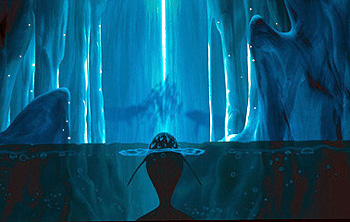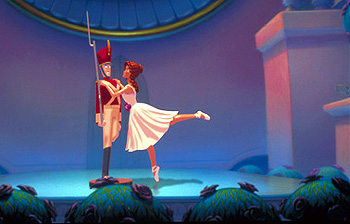

The original release of Fantasia in 1940 brought mixed results. Walt Disney tried to bring classical music to the masses, but the masses were indifferent. With each re-release, popularity gained until Fantasia became one of the more beloved Disney movies. Disney intended to change some of the selections with each re-release, but this never happened. Sixty years later, Roy Disney fulfills his brother's dream of a new Fantasia, Fantasia 2000. There are seven new selections and one old one, The Sorcerer's Apprentice, which is probably Mickey Mouse's most famous role. Adding to the grandeur is the decision to release the movie in the IMAX format, with its unbelievably large screen, and performances by the Chicago Symphony Orchestra.
The musical selections are a mixed bag. Some of the sequences soar with majesty and bring smiles all around, others kind of make people shake their heads. One of these is Beethoven's Symphony No. 5. Sure it's a wonderful piece of work, but who hasn't heard it? Under the direction of Pixote Hunt, surreal butterflies flit across the screen in living clouds. The other strange selection is Sir Edward Elgar's Pomp and Circumstance, Marches 1, 2, 3, and 4. For anyone who doesn't know, this song plays at every single graduation. Donald Duck takes on the role of Noah, gathering two of every animal for the ark in this piece. Thankfully, the entirety of the piece is played, not just the familiar portion. In between each selection is a celebrity interlude, with a small dose of humor. These pieces are mainly for introducing the following piece, so the viewer has an idea of what will be heard. The Sorcerer's Apprentice, as good as it is, just does not belong on IMAX. Although the piece is still inspiring, the large screen brings out the graininess of the old animation. Steve Martin, Penn and Teller, Bette Midler, and James Earl Jones and the others just don't seem to belong in the film, and the pauses bring the film to a halt. Interestingly enough, after each piece, the screen fades to black for a couple seconds, before returning to the orchestra, apparently to allow people to applaud, as if they were at the symphony. Alas, no one knew this, thus silence.
The better segments are much better. Eric Goldberg directs George Gershwin's Rhapsody In Blue (another piece heard everywhere, just don't think United while watching) to an Al Hirschfeld inspired New York in the early part of the century. The mix of purples and pinks is odd at first, but becomes appealing as the piece progresses. In it, the lives of various people in New York are followed over the course of the day. The Steadfast Tin Solder and the flamingo are classic Disney. The former is a retelling of Hans Christian Andersen's classic fairy tale to Dmitri Shostakovich's Piano Concerto No. 2, Allegro, Opus 102. A toy soldier falls in love with a ballerina, and must battle a jealous jack-in-the-box. In the latter, the question "what would a flamingo do with a yo-yo" is answered, to Camille Saint-Saens Carnival of the Animals, Finale. This is the most amusing segment of the movie; surprisingly satisfying given the seeming lackluster premise. Igor Stravinsky's Firebird Suite-1919 Version sets the stage for a story of life, death and rebirth, in a story stylistically reminiscent of Princess Mononoke. Towering above all other pieces in Fantasia 2000 is Hendel Butoy's segment to Ottorino Resphigi's Pines of Rome. Computer generated whales swim through the water and fly majestically through the air. Here, the IMAX screen increases the level of awe in the movie. So overall, the goods outweigh the bad five to four. Fantasia 2000 is not a great film, but it sure is fun to watch.